American Eagle Outfitters Equity Valuation Report: Finance Module
VerifiedAdded on 2023/04/12
|12
|2275
|172
Report
AI Summary
This report presents an equity valuation of American Eagle Outfitters (AEO) using two primary valuation techniques: Residual Earnings Analysis and Discounted Cash Flow (DCF). The analysis utilizes financial data from 2015, 2016, and 2017, extracted from the company's annual reports. The report begins with a company overview and industry context, followed by detailed calculations and explanations of both valuation methods. The Residual Earnings model incorporates comprehensive earnings and book value of equity to determine intrinsic value, while the DCF method forecasts future cash flows to ascertain the present value of the firm. The study also includes justifications for the usefulness of both techniques, highlighting their strengths in detailed analysis, capturing major business functions, and determining intrinsic value. The report concludes with a recommendation on the stock's valuation, based on the outcomes of both models, and a discussion of limitations. Excel spreadsheets were used for calculations.
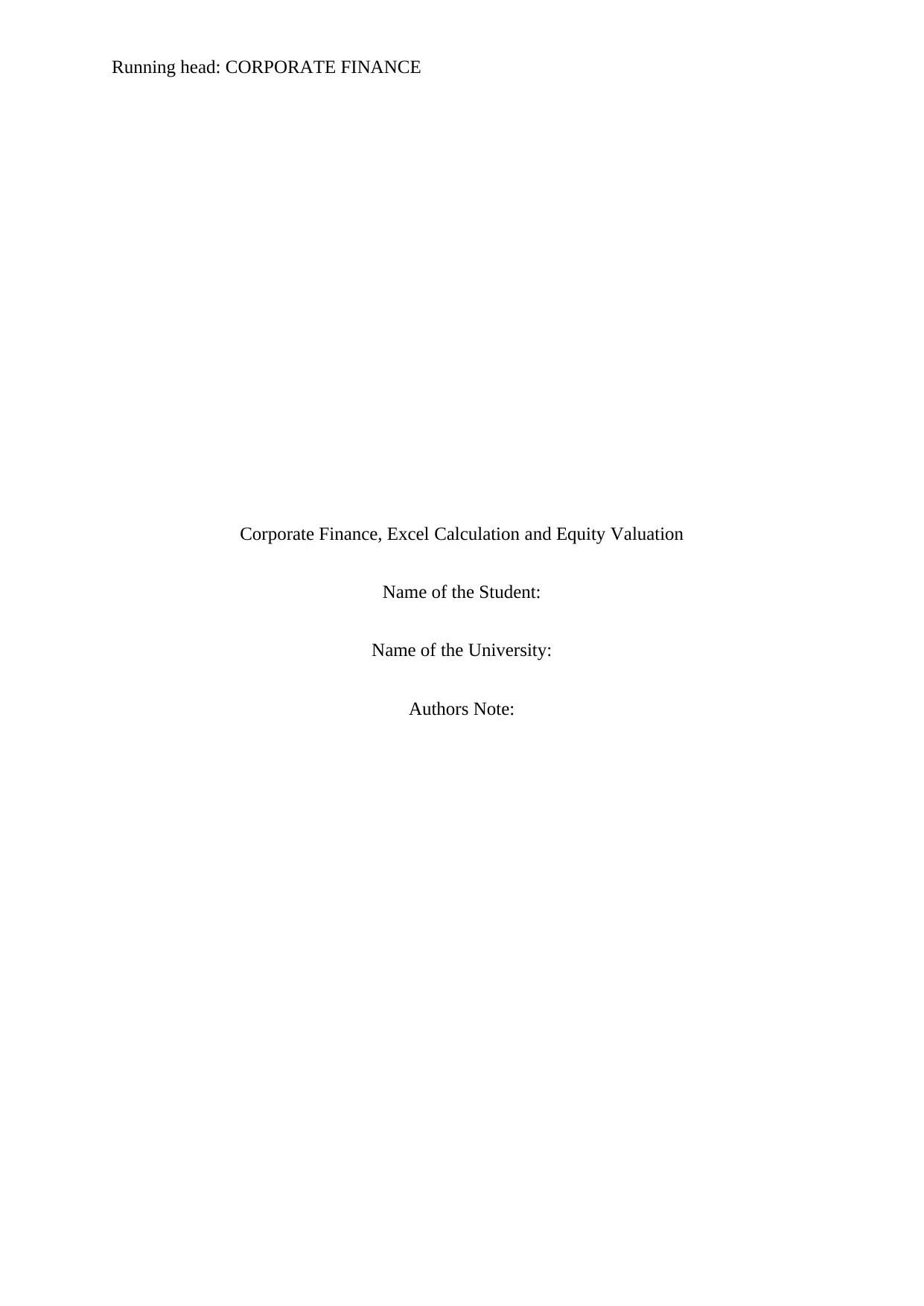
Running head: CORPORATE FINANCE
Corporate Finance, Excel Calculation and Equity Valuation
Name of the Student:
Name of the University:
Authors Note:
Corporate Finance, Excel Calculation and Equity Valuation
Name of the Student:
Name of the University:
Authors Note:
Paraphrase This Document
Need a fresh take? Get an instant paraphrase of this document with our AI Paraphraser
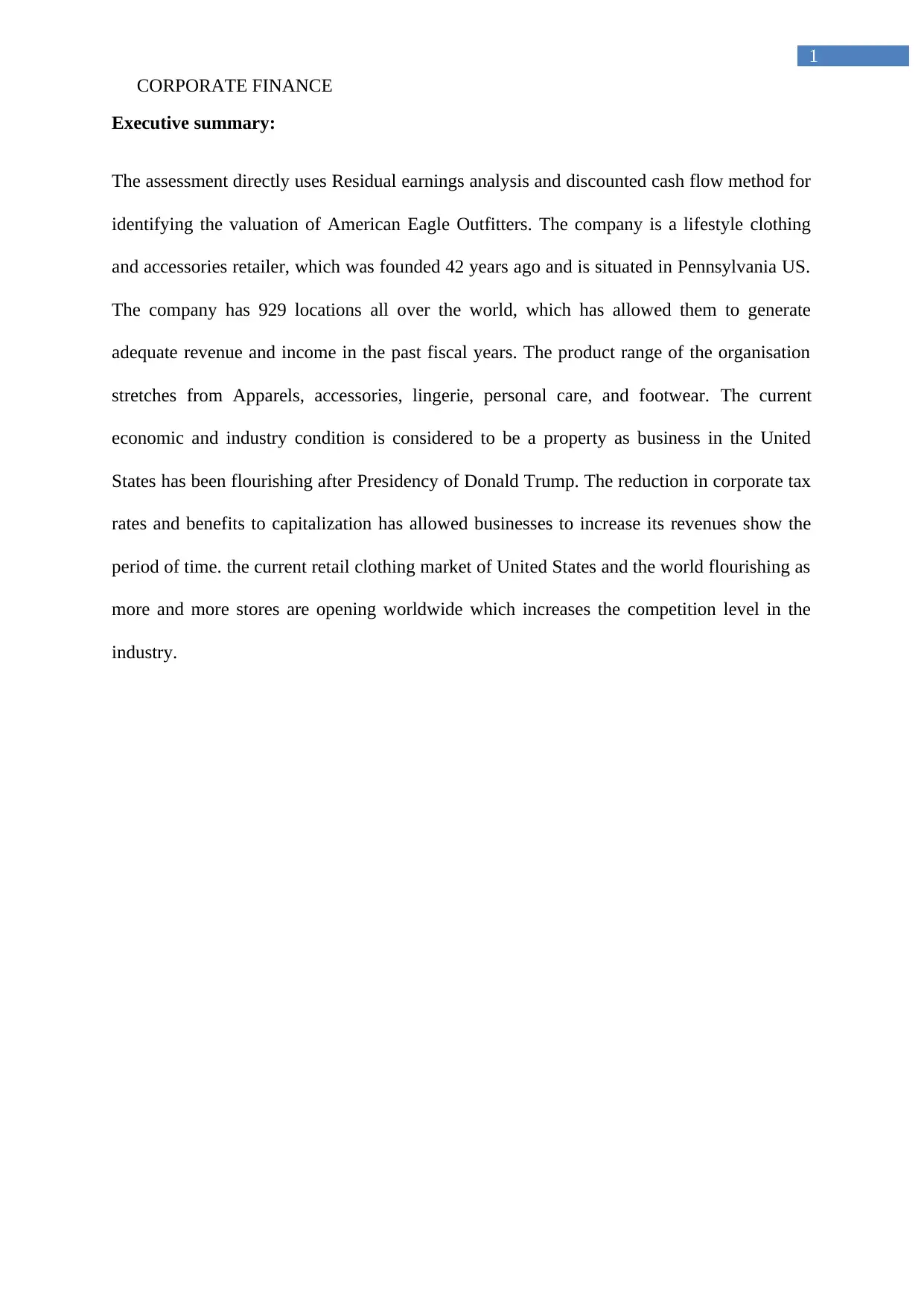
CORPORATE FINANCE
1
Executive summary:
The assessment directly uses Residual earnings analysis and discounted cash flow method for
identifying the valuation of American Eagle Outfitters. The company is a lifestyle clothing
and accessories retailer, which was founded 42 years ago and is situated in Pennsylvania US.
The company has 929 locations all over the world, which has allowed them to generate
adequate revenue and income in the past fiscal years. The product range of the organisation
stretches from Apparels, accessories, lingerie, personal care, and footwear. The current
economic and industry condition is considered to be a property as business in the United
States has been flourishing after Presidency of Donald Trump. The reduction in corporate tax
rates and benefits to capitalization has allowed businesses to increase its revenues show the
period of time. the current retail clothing market of United States and the world flourishing as
more and more stores are opening worldwide which increases the competition level in the
industry.
1
Executive summary:
The assessment directly uses Residual earnings analysis and discounted cash flow method for
identifying the valuation of American Eagle Outfitters. The company is a lifestyle clothing
and accessories retailer, which was founded 42 years ago and is situated in Pennsylvania US.
The company has 929 locations all over the world, which has allowed them to generate
adequate revenue and income in the past fiscal years. The product range of the organisation
stretches from Apparels, accessories, lingerie, personal care, and footwear. The current
economic and industry condition is considered to be a property as business in the United
States has been flourishing after Presidency of Donald Trump. The reduction in corporate tax
rates and benefits to capitalization has allowed businesses to increase its revenues show the
period of time. the current retail clothing market of United States and the world flourishing as
more and more stores are opening worldwide which increases the competition level in the
industry.
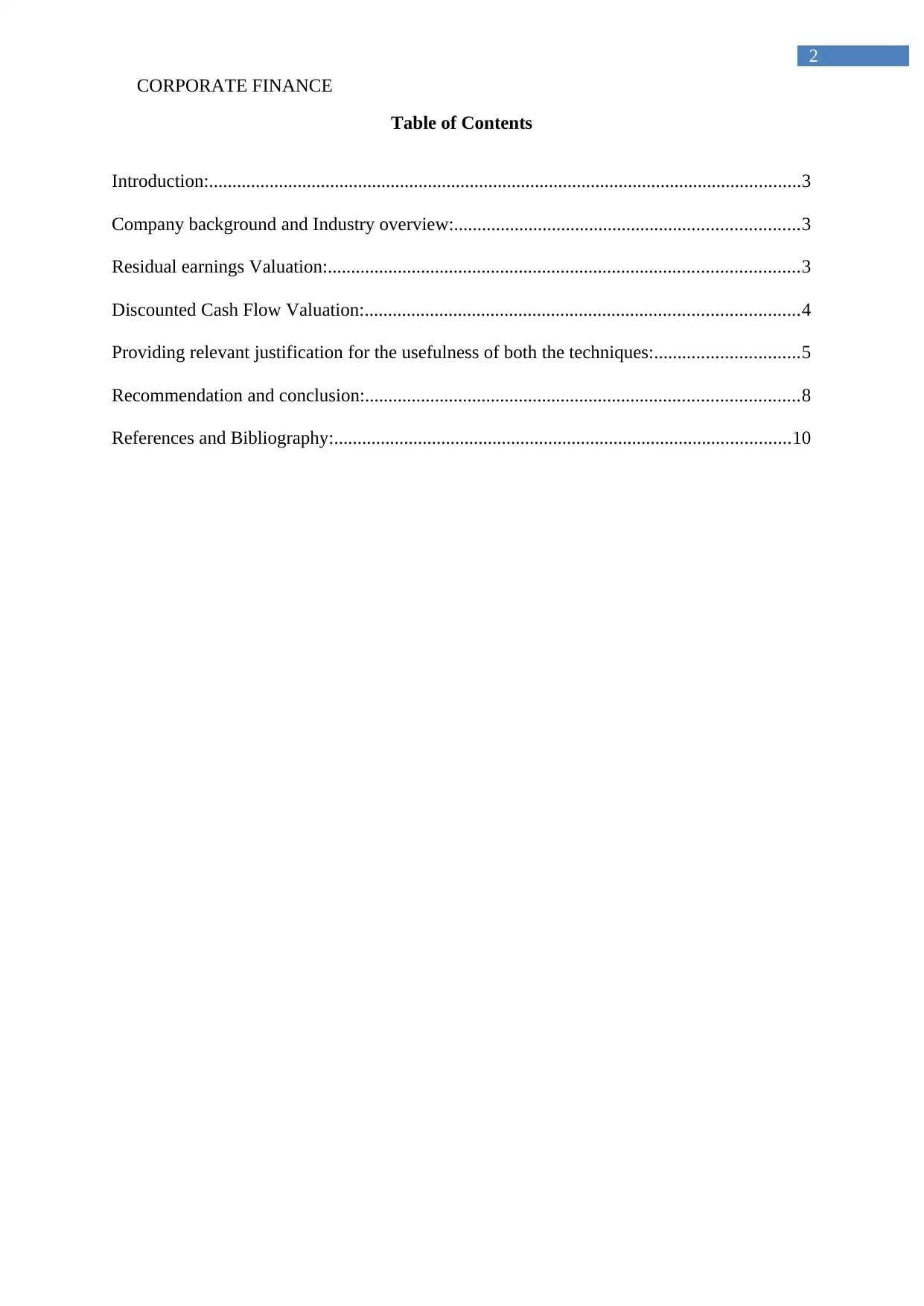
CORPORATE FINANCE
2
Table of Contents
Introduction:...............................................................................................................................3
Company background and Industry overview:..........................................................................3
Residual earnings Valuation:.....................................................................................................3
Discounted Cash Flow Valuation:.............................................................................................4
Providing relevant justification for the usefulness of both the techniques:...............................5
Recommendation and conclusion:.............................................................................................8
References and Bibliography:..................................................................................................10
2
Table of Contents
Introduction:...............................................................................................................................3
Company background and Industry overview:..........................................................................3
Residual earnings Valuation:.....................................................................................................3
Discounted Cash Flow Valuation:.............................................................................................4
Providing relevant justification for the usefulness of both the techniques:...............................5
Recommendation and conclusion:.............................................................................................8
References and Bibliography:..................................................................................................10
⊘ This is a preview!⊘
Do you want full access?
Subscribe today to unlock all pages.

Trusted by 1+ million students worldwide

CORPORATE FINANCE
3
Introduction:
The assessment aims in detecting the fundamental valuation of American Eagle
Outfitters Inc. under discounted cash flow and residual earnings method. The fundamental
analysis allows the investor to determine the intrinsic value of the firm, which helps in
detecting the book value of the firm. Thus, the measurement used for American Eagle
Outfitters Inc. can eventually help the investor in understanding the book value of the firm
and determine whether they are undervalued or overvalued.
Company background and Industry overview:
American Eagle Outfitters Inc. is a lifestyle clothing and accessories retailer, which
was founded 42 years ago and is situated in Pennsylvania US. The company has 929
locations all over the world, which has allowed them to generate adequate revenue and
income in the past fiscal years. The product range of the organisation stretches from
Apparels, accessories, lingerie, personal care, and footwear. The organisation has maintained
their expansion with the online shopping platform, which has helped in raising brand
recognition in new markets.
Residual earnings Valuation:
Residual Earnings Method
Particulars 2015 2016 2017
Comprehensive Earnings $ 198,214,000 $ 205,855,000 $ 209,830,000
Book value of equity $ 1,051,376,000 $ 1,204,569,000 $ 1,246,791,000
Return on equity 10.70% 10.70% 10.70%
Equity change $ 112,507,891 $ 128,901,095
Residual Earnings $ 93,347,109 $ 80,928,905
Discounting factor 1.107 1.225
PV of Residual Earnings $ 84,323,626.29 $ 66,038,996.99
Total RE $ 150,362,623.29
CV $ 921,742,422.92
3
Introduction:
The assessment aims in detecting the fundamental valuation of American Eagle
Outfitters Inc. under discounted cash flow and residual earnings method. The fundamental
analysis allows the investor to determine the intrinsic value of the firm, which helps in
detecting the book value of the firm. Thus, the measurement used for American Eagle
Outfitters Inc. can eventually help the investor in understanding the book value of the firm
and determine whether they are undervalued or overvalued.
Company background and Industry overview:
American Eagle Outfitters Inc. is a lifestyle clothing and accessories retailer, which
was founded 42 years ago and is situated in Pennsylvania US. The company has 929
locations all over the world, which has allowed them to generate adequate revenue and
income in the past fiscal years. The product range of the organisation stretches from
Apparels, accessories, lingerie, personal care, and footwear. The organisation has maintained
their expansion with the online shopping platform, which has helped in raising brand
recognition in new markets.
Residual earnings Valuation:
Residual Earnings Method
Particulars 2015 2016 2017
Comprehensive Earnings $ 198,214,000 $ 205,855,000 $ 209,830,000
Book value of equity $ 1,051,376,000 $ 1,204,569,000 $ 1,246,791,000
Return on equity 10.70% 10.70% 10.70%
Equity change $ 112,507,891 $ 128,901,095
Residual Earnings $ 93,347,109 $ 80,928,905
Discounting factor 1.107 1.225
PV of Residual Earnings $ 84,323,626.29 $ 66,038,996.99
Total RE $ 150,362,623.29
CV $ 921,742,422.92
Paraphrase This Document
Need a fresh take? Get an instant paraphrase of this document with our AI Paraphraser
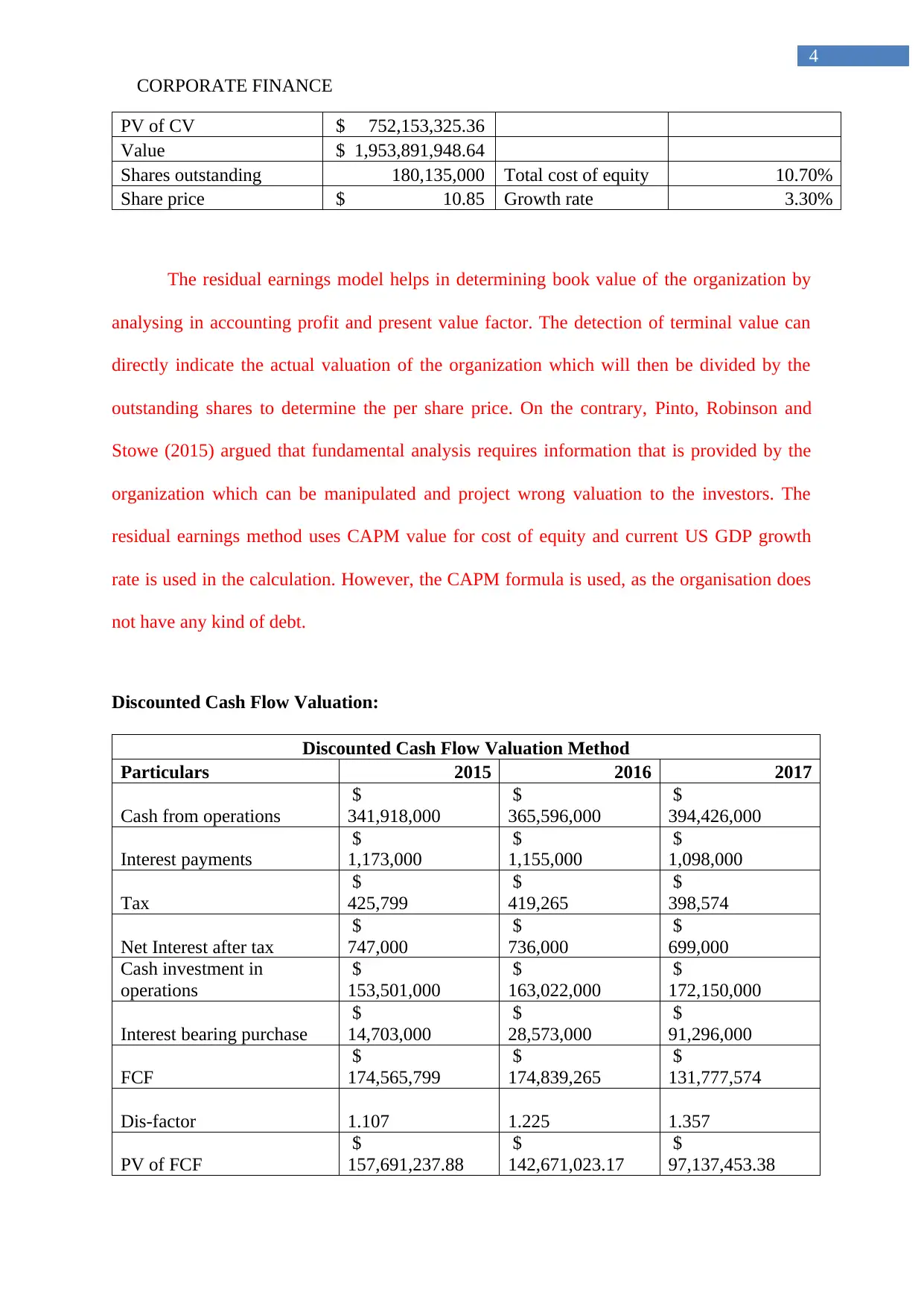
CORPORATE FINANCE
4
PV of CV $ 752,153,325.36
Value $ 1,953,891,948.64
Shares outstanding 180,135,000 Total cost of equity 10.70%
Share price $ 10.85 Growth rate 3.30%
The residual earnings model helps in determining book value of the organization by
analysing in accounting profit and present value factor. The detection of terminal value can
directly indicate the actual valuation of the organization which will then be divided by the
outstanding shares to determine the per share price. On the contrary, Pinto, Robinson and
Stowe (2015) argued that fundamental analysis requires information that is provided by the
organization which can be manipulated and project wrong valuation to the investors. The
residual earnings method uses CAPM value for cost of equity and current US GDP growth
rate is used in the calculation. However, the CAPM formula is used, as the organisation does
not have any kind of debt.
Discounted Cash Flow Valuation:
Discounted Cash Flow Valuation Method
Particulars 2015 2016 2017
Cash from operations
$
341,918,000
$
365,596,000
$
394,426,000
Interest payments
$
1,173,000
$
1,155,000
$
1,098,000
Tax
$
425,799
$
419,265
$
398,574
Net Interest after tax
$
747,000
$
736,000
$
699,000
Cash investment in
operations
$
153,501,000
$
163,022,000
$
172,150,000
Interest bearing purchase
$
14,703,000
$
28,573,000
$
91,296,000
FCF
$
174,565,799
$
174,839,265
$
131,777,574
Dis-factor 1.107 1.225 1.357
PV of FCF
$
157,691,237.88
$
142,671,023.17
$
97,137,453.38
4
PV of CV $ 752,153,325.36
Value $ 1,953,891,948.64
Shares outstanding 180,135,000 Total cost of equity 10.70%
Share price $ 10.85 Growth rate 3.30%
The residual earnings model helps in determining book value of the organization by
analysing in accounting profit and present value factor. The detection of terminal value can
directly indicate the actual valuation of the organization which will then be divided by the
outstanding shares to determine the per share price. On the contrary, Pinto, Robinson and
Stowe (2015) argued that fundamental analysis requires information that is provided by the
organization which can be manipulated and project wrong valuation to the investors. The
residual earnings method uses CAPM value for cost of equity and current US GDP growth
rate is used in the calculation. However, the CAPM formula is used, as the organisation does
not have any kind of debt.
Discounted Cash Flow Valuation:
Discounted Cash Flow Valuation Method
Particulars 2015 2016 2017
Cash from operations
$
341,918,000
$
365,596,000
$
394,426,000
Interest payments
$
1,173,000
$
1,155,000
$
1,098,000
Tax
$
425,799
$
419,265
$
398,574
Net Interest after tax
$
747,000
$
736,000
$
699,000
Cash investment in
operations
$
153,501,000
$
163,022,000
$
172,150,000
Interest bearing purchase
$
14,703,000
$
28,573,000
$
91,296,000
FCF
$
174,565,799
$
174,839,265
$
131,777,574
Dis-factor 1.107 1.225 1.357
PV of FCF
$
157,691,237.88
$
142,671,023.17
$
97,137,453.38
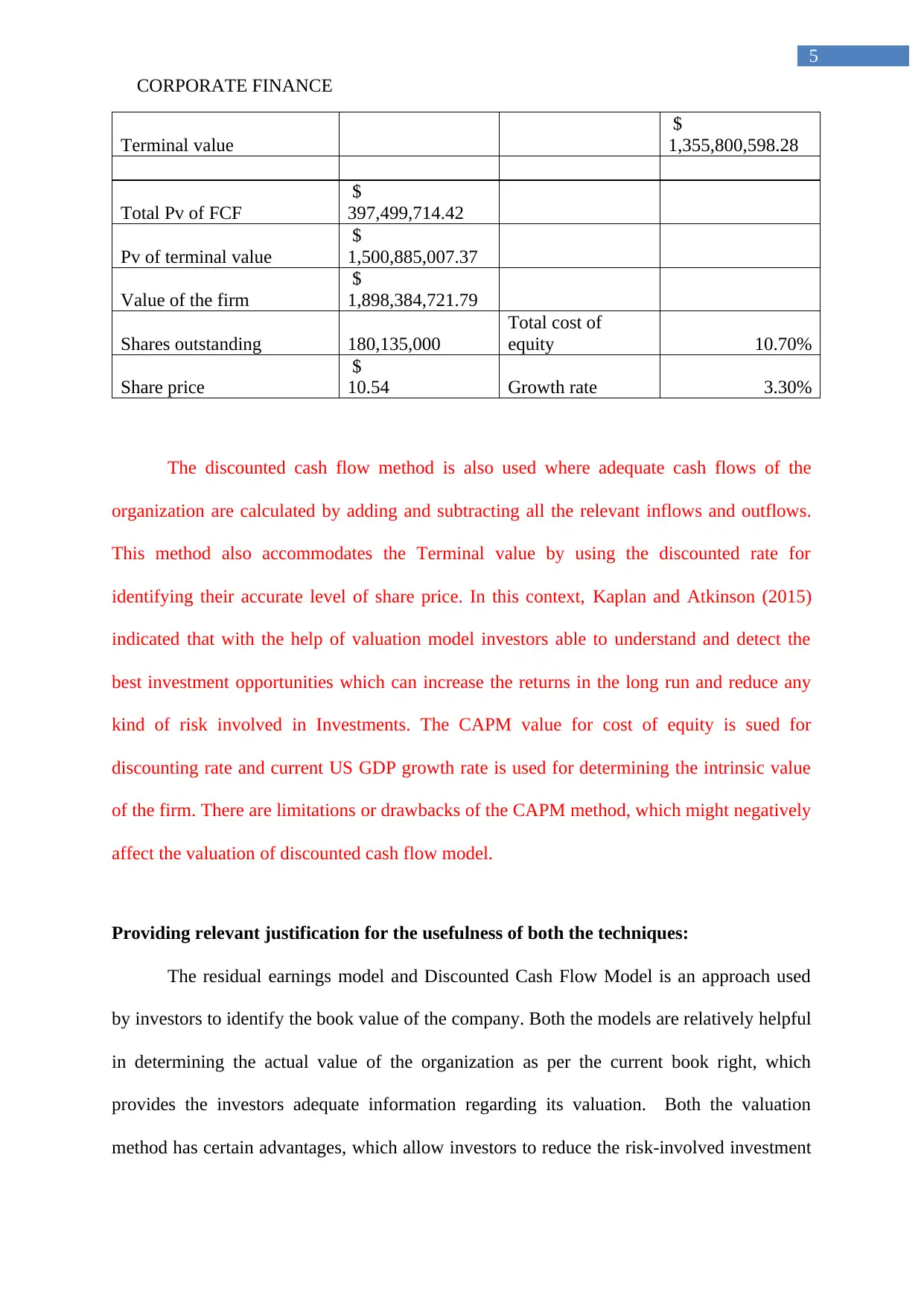
CORPORATE FINANCE
5
Terminal value
$
1,355,800,598.28
Total Pv of FCF
$
397,499,714.42
Pv of terminal value
$
1,500,885,007.37
Value of the firm
$
1,898,384,721.79
Shares outstanding 180,135,000
Total cost of
equity 10.70%
Share price
$
10.54 Growth rate 3.30%
The discounted cash flow method is also used where adequate cash flows of the
organization are calculated by adding and subtracting all the relevant inflows and outflows.
This method also accommodates the Terminal value by using the discounted rate for
identifying their accurate level of share price. In this context, Kaplan and Atkinson (2015)
indicated that with the help of valuation model investors able to understand and detect the
best investment opportunities which can increase the returns in the long run and reduce any
kind of risk involved in Investments. The CAPM value for cost of equity is sued for
discounting rate and current US GDP growth rate is used for determining the intrinsic value
of the firm. There are limitations or drawbacks of the CAPM method, which might negatively
affect the valuation of discounted cash flow model.
Providing relevant justification for the usefulness of both the techniques:
The residual earnings model and Discounted Cash Flow Model is an approach used
by investors to identify the book value of the company. Both the models are relatively helpful
in determining the actual value of the organization as per the current book right, which
provides the investors adequate information regarding its valuation. Both the valuation
method has certain advantages, which allow investors to reduce the risk-involved investment
5
Terminal value
$
1,355,800,598.28
Total Pv of FCF
$
397,499,714.42
Pv of terminal value
$
1,500,885,007.37
Value of the firm
$
1,898,384,721.79
Shares outstanding 180,135,000
Total cost of
equity 10.70%
Share price
$
10.54 Growth rate 3.30%
The discounted cash flow method is also used where adequate cash flows of the
organization are calculated by adding and subtracting all the relevant inflows and outflows.
This method also accommodates the Terminal value by using the discounted rate for
identifying their accurate level of share price. In this context, Kaplan and Atkinson (2015)
indicated that with the help of valuation model investors able to understand and detect the
best investment opportunities which can increase the returns in the long run and reduce any
kind of risk involved in Investments. The CAPM value for cost of equity is sued for
discounting rate and current US GDP growth rate is used for determining the intrinsic value
of the firm. There are limitations or drawbacks of the CAPM method, which might negatively
affect the valuation of discounted cash flow model.
Providing relevant justification for the usefulness of both the techniques:
The residual earnings model and Discounted Cash Flow Model is an approach used
by investors to identify the book value of the company. Both the models are relatively helpful
in determining the actual value of the organization as per the current book right, which
provides the investors adequate information regarding its valuation. Both the valuation
method has certain advantages, which allow investors to reduce the risk-involved investment
⊘ This is a preview!⊘
Do you want full access?
Subscribe today to unlock all pages.

Trusted by 1+ million students worldwide
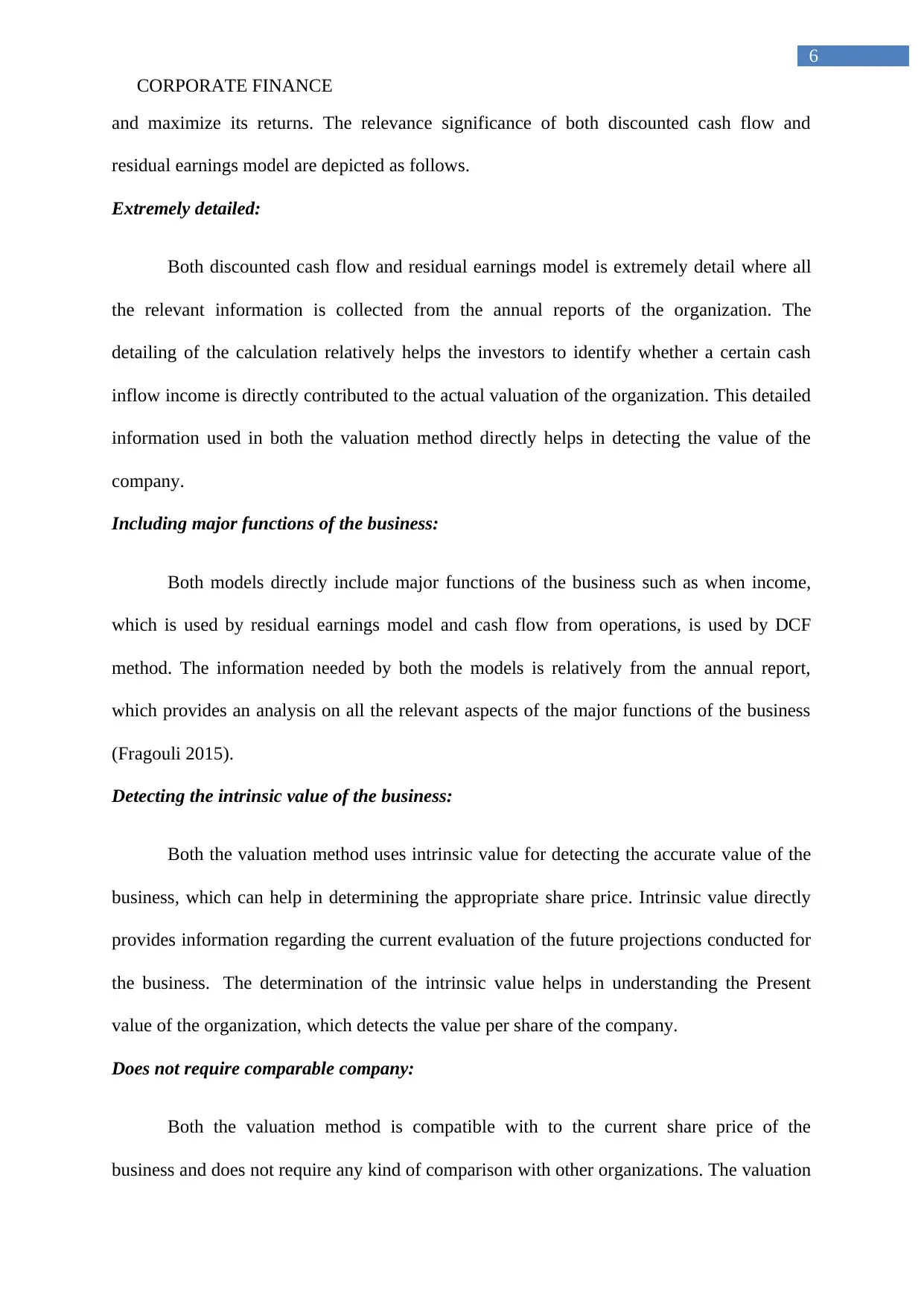
CORPORATE FINANCE
6
and maximize its returns. The relevance significance of both discounted cash flow and
residual earnings model are depicted as follows.
Extremely detailed:
Both discounted cash flow and residual earnings model is extremely detail where all
the relevant information is collected from the annual reports of the organization. The
detailing of the calculation relatively helps the investors to identify whether a certain cash
inflow income is directly contributed to the actual valuation of the organization. This detailed
information used in both the valuation method directly helps in detecting the value of the
company.
Including major functions of the business:
Both models directly include major functions of the business such as when income,
which is used by residual earnings model and cash flow from operations, is used by DCF
method. The information needed by both the models is relatively from the annual report,
which provides an analysis on all the relevant aspects of the major functions of the business
(Fragouli 2015).
Detecting the intrinsic value of the business:
Both the valuation method uses intrinsic value for detecting the accurate value of the
business, which can help in determining the appropriate share price. Intrinsic value directly
provides information regarding the current evaluation of the future projections conducted for
the business. The determination of the intrinsic value helps in understanding the Present
value of the organization, which detects the value per share of the company.
Does not require comparable company:
Both the valuation method is compatible with to the current share price of the
business and does not require any kind of comparison with other organizations. The valuation
6
and maximize its returns. The relevance significance of both discounted cash flow and
residual earnings model are depicted as follows.
Extremely detailed:
Both discounted cash flow and residual earnings model is extremely detail where all
the relevant information is collected from the annual reports of the organization. The
detailing of the calculation relatively helps the investors to identify whether a certain cash
inflow income is directly contributed to the actual valuation of the organization. This detailed
information used in both the valuation method directly helps in detecting the value of the
company.
Including major functions of the business:
Both models directly include major functions of the business such as when income,
which is used by residual earnings model and cash flow from operations, is used by DCF
method. The information needed by both the models is relatively from the annual report,
which provides an analysis on all the relevant aspects of the major functions of the business
(Fragouli 2015).
Detecting the intrinsic value of the business:
Both the valuation method uses intrinsic value for detecting the accurate value of the
business, which can help in determining the appropriate share price. Intrinsic value directly
provides information regarding the current evaluation of the future projections conducted for
the business. The determination of the intrinsic value helps in understanding the Present
value of the organization, which detects the value per share of the company.
Does not require comparable company:
Both the valuation method is compatible with to the current share price of the
business and does not require any kind of comparison with other organizations. The valuation
Paraphrase This Document
Need a fresh take? Get an instant paraphrase of this document with our AI Paraphraser

CORPORATE FINANCE
7
method relatively provides the book value of the current organization, which is compared
with its current market value. This provides the relative information to the investors regarding
the current valuation of the shares, which help then make adequate investment decisions.
Includes future expectation of a business:
Both the model uses adequate growth factors to determine the future cash flows and
earnings of the organization. The models understanding the accurate value of the organization
require this detection of the future cash flows and earnings. Thus, future Expectations of a
business is used in both the models for detecting the terminal value or intrinsic value, which
is then discounted to the current year for identifying the actual valuation of the organization
(Christersson, Vimpari and Junnila 2015).
Suitable for analysing merger and acquisition:
The discounted cash flow method is adequate to identify the actual merger and
acquisition of an organization, which depicts the future cash flows of the merged
organization. However, residual earnings method only detects the future earnings of the
merged organization, which projects the anticipated valuation of the company. Thus,
investors can adequately analyses the merger and acquisition with the help of both models
and make relevant investment decisions to improve their returns. Hence, investors can detect
the valuation of the company after its merger or acquisition.
Conducting scenario analysis and Sensitivity Analysis:
Scenario analysis can be conducted on both residual earnings method and discounted
cash flow method by using the growth factor and cost of capital. This scenario analysis will
allow the investors to identify whether the stock price could increase or decrease at a certain
face due to the fluctuations in growth rate and cost of capital. Both the methods support the
7
method relatively provides the book value of the current organization, which is compared
with its current market value. This provides the relative information to the investors regarding
the current valuation of the shares, which help then make adequate investment decisions.
Includes future expectation of a business:
Both the model uses adequate growth factors to determine the future cash flows and
earnings of the organization. The models understanding the accurate value of the organization
require this detection of the future cash flows and earnings. Thus, future Expectations of a
business is used in both the models for detecting the terminal value or intrinsic value, which
is then discounted to the current year for identifying the actual valuation of the organization
(Christersson, Vimpari and Junnila 2015).
Suitable for analysing merger and acquisition:
The discounted cash flow method is adequate to identify the actual merger and
acquisition of an organization, which depicts the future cash flows of the merged
organization. However, residual earnings method only detects the future earnings of the
merged organization, which projects the anticipated valuation of the company. Thus,
investors can adequately analyses the merger and acquisition with the help of both models
and make relevant investment decisions to improve their returns. Hence, investors can detect
the valuation of the company after its merger or acquisition.
Conducting scenario analysis and Sensitivity Analysis:
Scenario analysis can be conducted on both residual earnings method and discounted
cash flow method by using the growth factor and cost of capital. This scenario analysis will
allow the investors to identify whether the stock price could increase or decrease at a certain
face due to the fluctuations in growth rate and cost of capital. Both the methods support the

CORPORATE FINANCE
8
scenario analysis which can be calculated under different circumstances and identify the best
possible investment options.
Sensitivity analysis can also be conducted in both the models by projecting different
growth factors and cost of capital for the organization, which can change in due time. The
sensitivity analysis can project the anticipated theoretical share price value of the
organization as per the book value. This detection would eventually allow the investors to
understand the different levels under which share price of an organization, can alter in future
(Budagaga 2017).
Therefore, the combined scenario analysis and sensitivity analysis can allow the
investors to understand the actual fluctuations that are present within the share price of an
organization. These fluctuations are relatively affected by the growth factors and cost of
capital of an organization. The growth factors are anticipated on the dividends that are
provided by the organization over the historical period. Moreover, the cost of capital is
derived by using the weighted average cost of capital of an organization, which actually
portrays the minimum returns that needs to be achieved by an organization during the fiscal
year.
Recommendation and conclusion:
The calculations conducted in the above table directly provide adequate valuation of
American Eagle Outfitters Inc. under Residual Earnings Method and Discounted Cash Flow
Method. The valuations have indicated the theoretical share price of the organization, which
in turn helps in determining whether the organization is overvalued or undervalued. This
detection of adequate valuation would eventually allow the investors to understand whether
the stock is appropriate for buying or selling. Both the methods have different approaches to
determine the appropriate book value of the organization. Therefore, under residual earnings
8
scenario analysis which can be calculated under different circumstances and identify the best
possible investment options.
Sensitivity analysis can also be conducted in both the models by projecting different
growth factors and cost of capital for the organization, which can change in due time. The
sensitivity analysis can project the anticipated theoretical share price value of the
organization as per the book value. This detection would eventually allow the investors to
understand the different levels under which share price of an organization, can alter in future
(Budagaga 2017).
Therefore, the combined scenario analysis and sensitivity analysis can allow the
investors to understand the actual fluctuations that are present within the share price of an
organization. These fluctuations are relatively affected by the growth factors and cost of
capital of an organization. The growth factors are anticipated on the dividends that are
provided by the organization over the historical period. Moreover, the cost of capital is
derived by using the weighted average cost of capital of an organization, which actually
portrays the minimum returns that needs to be achieved by an organization during the fiscal
year.
Recommendation and conclusion:
The calculations conducted in the above table directly provide adequate valuation of
American Eagle Outfitters Inc. under Residual Earnings Method and Discounted Cash Flow
Method. The valuations have indicated the theoretical share price of the organization, which
in turn helps in determining whether the organization is overvalued or undervalued. This
detection of adequate valuation would eventually allow the investors to understand whether
the stock is appropriate for buying or selling. Both the methods have different approaches to
determine the appropriate book value of the organization. Therefore, under residual earnings
⊘ This is a preview!⊘
Do you want full access?
Subscribe today to unlock all pages.

Trusted by 1+ million students worldwide
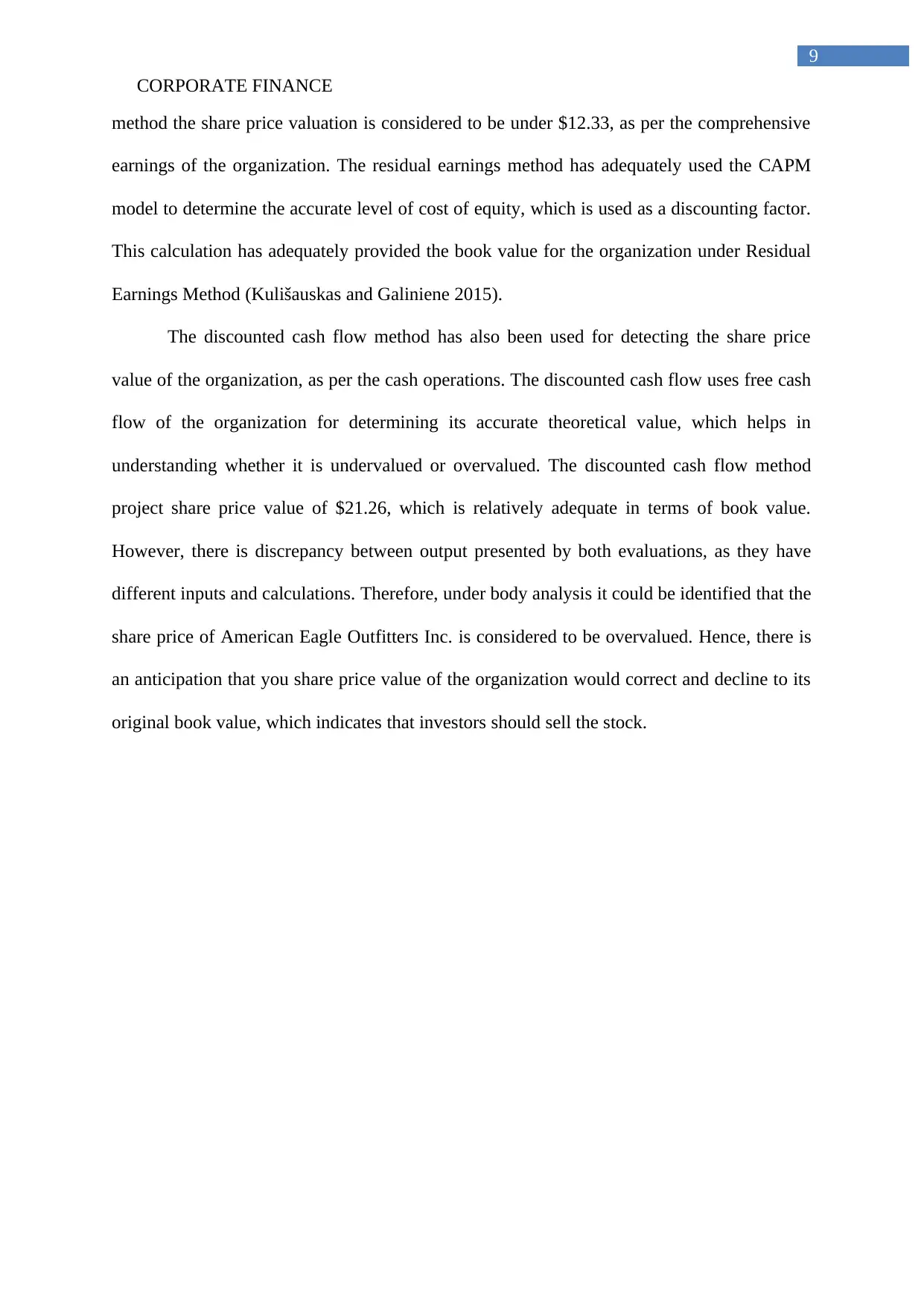
CORPORATE FINANCE
9
method the share price valuation is considered to be under $12.33, as per the comprehensive
earnings of the organization. The residual earnings method has adequately used the CAPM
model to determine the accurate level of cost of equity, which is used as a discounting factor.
This calculation has adequately provided the book value for the organization under Residual
Earnings Method (Kulišauskas and Galiniene 2015).
The discounted cash flow method has also been used for detecting the share price
value of the organization, as per the cash operations. The discounted cash flow uses free cash
flow of the organization for determining its accurate theoretical value, which helps in
understanding whether it is undervalued or overvalued. The discounted cash flow method
project share price value of $21.26, which is relatively adequate in terms of book value.
However, there is discrepancy between output presented by both evaluations, as they have
different inputs and calculations. Therefore, under body analysis it could be identified that the
share price of American Eagle Outfitters Inc. is considered to be overvalued. Hence, there is
an anticipation that you share price value of the organization would correct and decline to its
original book value, which indicates that investors should sell the stock.
9
method the share price valuation is considered to be under $12.33, as per the comprehensive
earnings of the organization. The residual earnings method has adequately used the CAPM
model to determine the accurate level of cost of equity, which is used as a discounting factor.
This calculation has adequately provided the book value for the organization under Residual
Earnings Method (Kulišauskas and Galiniene 2015).
The discounted cash flow method has also been used for detecting the share price
value of the organization, as per the cash operations. The discounted cash flow uses free cash
flow of the organization for determining its accurate theoretical value, which helps in
understanding whether it is undervalued or overvalued. The discounted cash flow method
project share price value of $21.26, which is relatively adequate in terms of book value.
However, there is discrepancy between output presented by both evaluations, as they have
different inputs and calculations. Therefore, under body analysis it could be identified that the
share price of American Eagle Outfitters Inc. is considered to be overvalued. Hence, there is
an anticipation that you share price value of the organization would correct and decline to its
original book value, which indicates that investors should sell the stock.
Paraphrase This Document
Need a fresh take? Get an instant paraphrase of this document with our AI Paraphraser
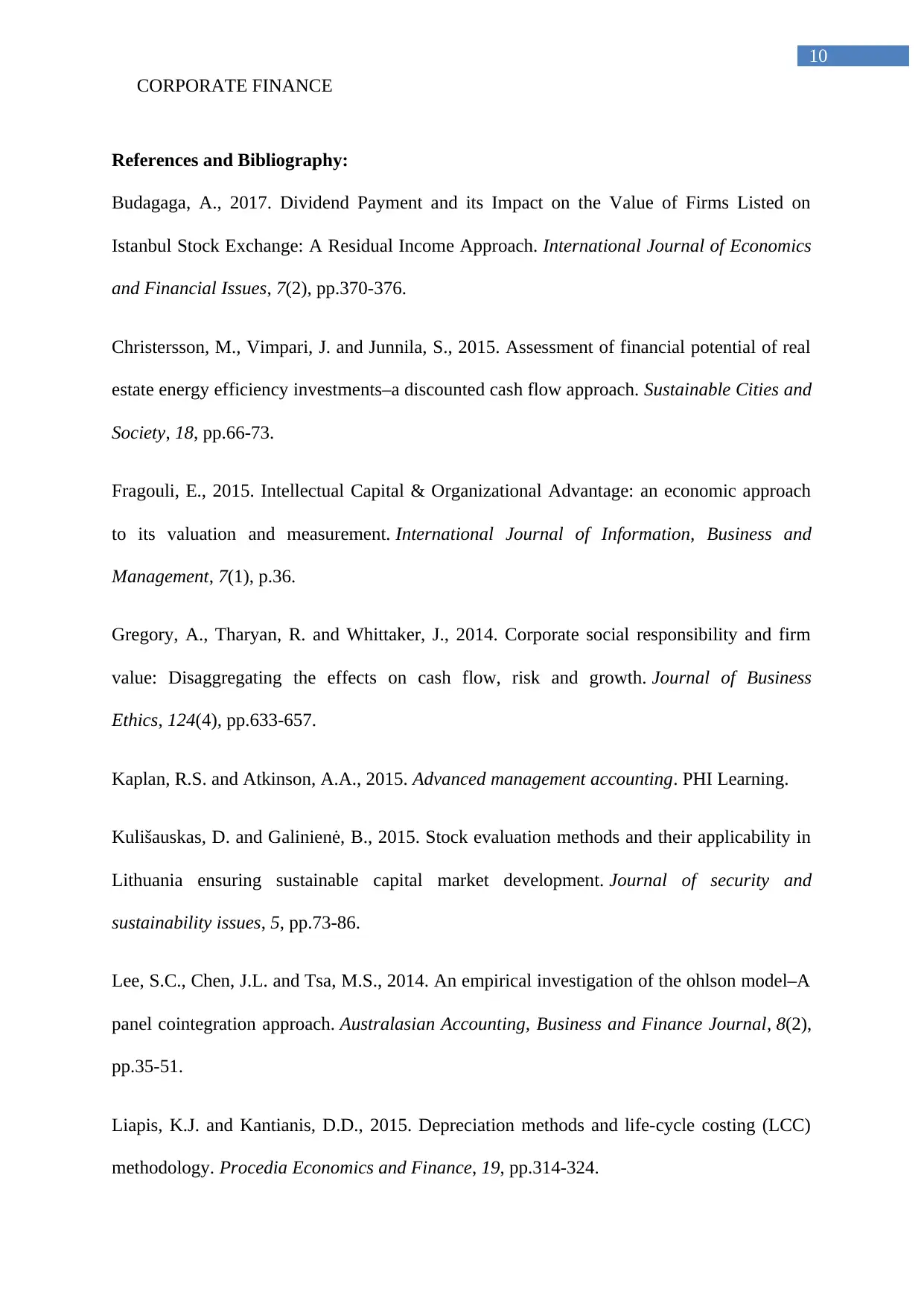
CORPORATE FINANCE
10
References and Bibliography:
Budagaga, A., 2017. Dividend Payment and its Impact on the Value of Firms Listed on
Istanbul Stock Exchange: A Residual Income Approach. International Journal of Economics
and Financial Issues, 7(2), pp.370-376.
Christersson, M., Vimpari, J. and Junnila, S., 2015. Assessment of financial potential of real
estate energy efficiency investments–a discounted cash flow approach. Sustainable Cities and
Society, 18, pp.66-73.
Fragouli, E., 2015. Intellectual Capital & Organizational Advantage: an economic approach
to its valuation and measurement. International Journal of Information, Business and
Management, 7(1), p.36.
Gregory, A., Tharyan, R. and Whittaker, J., 2014. Corporate social responsibility and firm
value: Disaggregating the effects on cash flow, risk and growth. Journal of Business
Ethics, 124(4), pp.633-657.
Kaplan, R.S. and Atkinson, A.A., 2015. Advanced management accounting. PHI Learning.
Kulišauskas, D. and Galinienė, B., 2015. Stock evaluation methods and their applicability in
Lithuania ensuring sustainable capital market development. Journal of security and
sustainability issues, 5, pp.73-86.
Lee, S.C., Chen, J.L. and Tsa, M.S., 2014. An empirical investigation of the ohlson model–A
panel cointegration approach. Australasian Accounting, Business and Finance Journal, 8(2),
pp.35-51.
Liapis, K.J. and Kantianis, D.D., 2015. Depreciation methods and life-cycle costing (LCC)
methodology. Procedia Economics and Finance, 19, pp.314-324.
10
References and Bibliography:
Budagaga, A., 2017. Dividend Payment and its Impact on the Value of Firms Listed on
Istanbul Stock Exchange: A Residual Income Approach. International Journal of Economics
and Financial Issues, 7(2), pp.370-376.
Christersson, M., Vimpari, J. and Junnila, S., 2015. Assessment of financial potential of real
estate energy efficiency investments–a discounted cash flow approach. Sustainable Cities and
Society, 18, pp.66-73.
Fragouli, E., 2015. Intellectual Capital & Organizational Advantage: an economic approach
to its valuation and measurement. International Journal of Information, Business and
Management, 7(1), p.36.
Gregory, A., Tharyan, R. and Whittaker, J., 2014. Corporate social responsibility and firm
value: Disaggregating the effects on cash flow, risk and growth. Journal of Business
Ethics, 124(4), pp.633-657.
Kaplan, R.S. and Atkinson, A.A., 2015. Advanced management accounting. PHI Learning.
Kulišauskas, D. and Galinienė, B., 2015. Stock evaluation methods and their applicability in
Lithuania ensuring sustainable capital market development. Journal of security and
sustainability issues, 5, pp.73-86.
Lee, S.C., Chen, J.L. and Tsa, M.S., 2014. An empirical investigation of the ohlson model–A
panel cointegration approach. Australasian Accounting, Business and Finance Journal, 8(2),
pp.35-51.
Liapis, K.J. and Kantianis, D.D., 2015. Depreciation methods and life-cycle costing (LCC)
methodology. Procedia Economics and Finance, 19, pp.314-324.
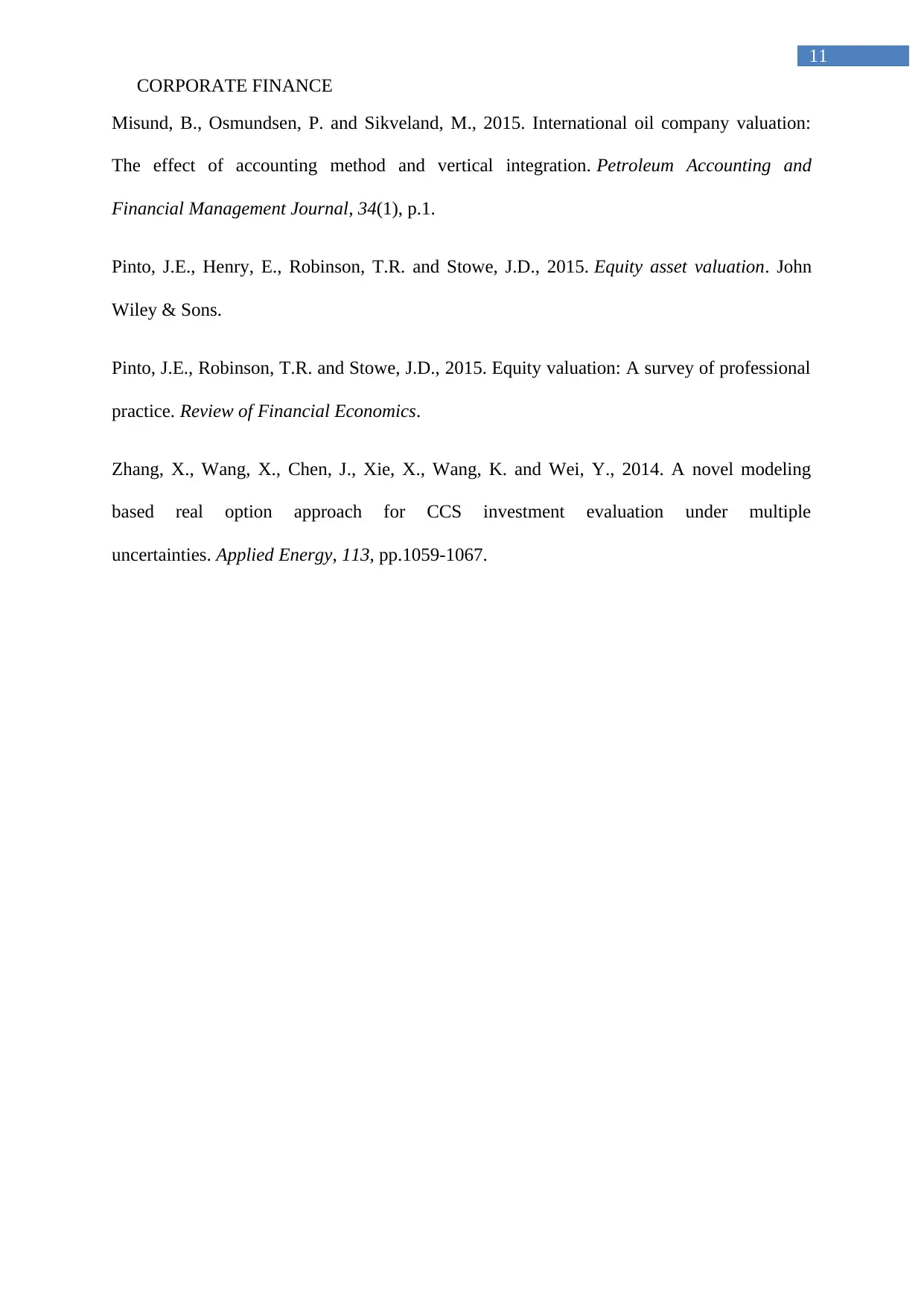
CORPORATE FINANCE
11
Misund, B., Osmundsen, P. and Sikveland, M., 2015. International oil company valuation:
The effect of accounting method and vertical integration. Petroleum Accounting and
Financial Management Journal, 34(1), p.1.
Pinto, J.E., Henry, E., Robinson, T.R. and Stowe, J.D., 2015. Equity asset valuation. John
Wiley & Sons.
Pinto, J.E., Robinson, T.R. and Stowe, J.D., 2015. Equity valuation: A survey of professional
practice. Review of Financial Economics.
Zhang, X., Wang, X., Chen, J., Xie, X., Wang, K. and Wei, Y., 2014. A novel modeling
based real option approach for CCS investment evaluation under multiple
uncertainties. Applied Energy, 113, pp.1059-1067.
11
Misund, B., Osmundsen, P. and Sikveland, M., 2015. International oil company valuation:
The effect of accounting method and vertical integration. Petroleum Accounting and
Financial Management Journal, 34(1), p.1.
Pinto, J.E., Henry, E., Robinson, T.R. and Stowe, J.D., 2015. Equity asset valuation. John
Wiley & Sons.
Pinto, J.E., Robinson, T.R. and Stowe, J.D., 2015. Equity valuation: A survey of professional
practice. Review of Financial Economics.
Zhang, X., Wang, X., Chen, J., Xie, X., Wang, K. and Wei, Y., 2014. A novel modeling
based real option approach for CCS investment evaluation under multiple
uncertainties. Applied Energy, 113, pp.1059-1067.
⊘ This is a preview!⊘
Do you want full access?
Subscribe today to unlock all pages.

Trusted by 1+ million students worldwide
1 out of 12
Your All-in-One AI-Powered Toolkit for Academic Success.
+13062052269
info@desklib.com
Available 24*7 on WhatsApp / Email
![[object Object]](/_next/static/media/star-bottom.7253800d.svg)
Unlock your academic potential
Copyright © 2020–2025 A2Z Services. All Rights Reserved. Developed and managed by ZUCOL.
